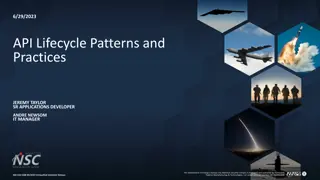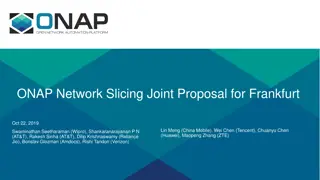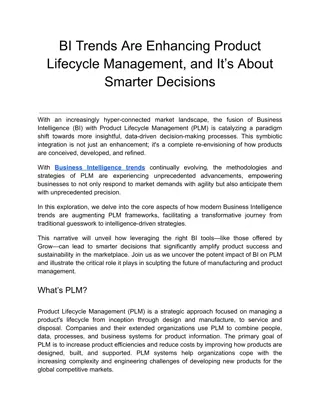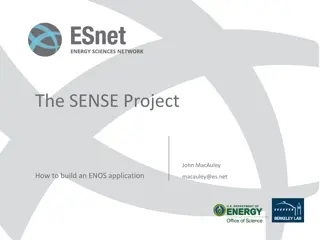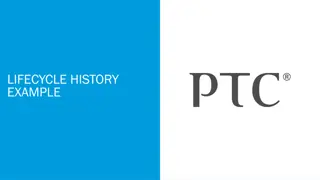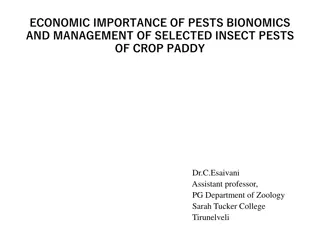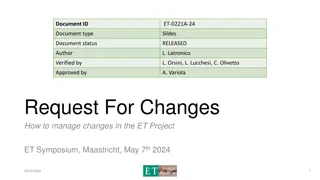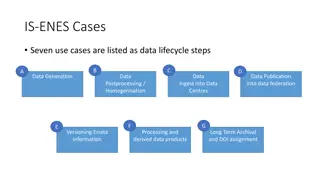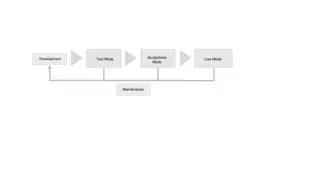
Data Science Project Process Overview
"Explore the essential stages of a data science project, including discovery, preparation, communication of results, and more. Learn about framing the problem, learning from past projects, and leveraging techniques, processes, and people effectively for successful outcomes in data science projects."
Download Presentation

Please find below an Image/Link to download the presentation.
The content on the website is provided AS IS for your information and personal use only. It may not be sold, licensed, or shared on other websites without obtaining consent from the author. If you encounter any issues during the download, it is possible that the publisher has removed the file from their server.
You are allowed to download the files provided on this website for personal or commercial use, subject to the condition that they are used lawfully. All files are the property of their respective owners.
The content on the website is provided AS IS for your information and personal use only. It may not be sold, licensed, or shared on other websites without obtaining consent from the author.
E N D
Presentation Transcript
Chapter 02 Process of Data Science Projects Dr. Steffen Herbold herbold@cs.uni-goettingen.de Introduction to Data Science https://sherbold.github.io/intro-to-data-science
Outline Generic Process Model Roles Core Deliverables Summary Introduction to Data Science https://sherbold.github.io/intro-to-data-science
Processes are Important Techniques Languages, tools, and methods Must be suited for the given problem People Require training for the techniques Should be guided through a project by a process Process Supports the people Must be accepted by the people Should have a measurable positive effect Techniques Processes People Introduction to Data Science https://sherbold.github.io/intro-to-data-science
Process of Data Science Projects Discovery Data Operationalize Preparation Communicate Results Model Planning Model Building Introduction to Data Science https://sherbold.github.io/intro-to-data-science
Discovery Initial phase of the project Learn the domain Knowledge for understanding the data and the use cases of the project Knowledge for the interpretation of the results Learn from the past Identify past projects on similar issues Differences, reasons for failures, weaknesses of past projects Can also be projects of competitors, if reports are available Introduction to Data Science https://sherbold.github.io/intro-to-data-science
Discovery Frame the problem Framing is the process of stating the data analysis problem to be solved Why is the problem important? Who are the key stakeholders and what are their interests in the project? What is the current situation and what are pain points that motivate the project? What are the objectives of the project? Business needs Research goals What needs to be done to achieve the objectives? What are success criteria for the project? What are risks for the project? Introduction to Data Science https://sherbold.github.io/intro-to-data-science
Discovery Begin learning the data Get a high-level understanding of the data Maybe even some initial statistics or visualizations of the data Determine requirements for data structures and tools for processing the data Formulate hypothesis Part of the Science in Data Science Should define expectations Feature X is well suited for the prediction of The following patterns will be found in the data: Deep learning will outperform Decision trees will perform well and allow insights into Should be discussed with stakeholders Introduction to Data Science https://sherbold.github.io/intro-to-data-science
Discovery Analyze available resources Technologies Resources for computation and storage Licenses for analysis frameworks Data Is the available data sufficient for the use case? Would other data be required and could the additional data be collected within the scope of the project? Timeframe Scope in calendar time and person months Human resources Who is available for the project? Is the skillset a good match for the tasks of the project? Only start project if the resources are sufficient! Introduction to Data Science https://sherbold.github.io/intro-to-data-science
Data Preparation Create the infrastructure for the project Usually different from infrastructure in which data is made available to you Warehouse/csv-file/ distributed storage that enables analysis Could also be simpler, for small data sizes Extract Transform Load (ETL) the data Define how to query existing database to extract required data Determine required transformations of the raw data Quality checking (e.g., filtering of missing data, implausible data) Structuring (e.g., for unstructured data, differences in data structures) Conversions (e.g., timestamps, character encodings) Load the data into your analysis environment Introduction to Data Science https://sherbold.github.io/intro-to-data-science
Data Preparation ELT vs. ETL Transformations can be very time-consuming for big data Might not be possible without using the analysis infrastructure Load raw data, transform afterwards ELT! Also allows more flexibility with transformations E.g., testing the effect of different transformations Allows access to raw data Introduction to Data Science https://sherbold.github.io/intro-to-data-science
Data Preparation Get a deep understanding of the data Understand all data sources E.g., what does each column in a relational database contain? How can a structure be imposed on semi-/quasi-/unstructured data? Survey and visualize data Descriptive statistics Correlation analysis Visualizations like histograms, density plots, pair-wise plots, etc. Clean and normalize data Discard data that is not required Normalize to remove scale effects Introduction to Data Science https://sherbold.github.io/intro-to-data-science
Data Preparation Clean data Discard data that is not required Can make the difference between a complex infrastructure and a single machine for analysis Example: 100 million measurements 10 floating point features per measurement 80 Bytes per measurement 3 useful features 24 Bytes per measurement 7.45 Gigabytes with all features, 2.23 Gigabytes with only useful features Can use my laptop for cleaned data without problems Introduction to Data Science https://sherbold.github.io/intro-to-data-science
Model Planning Determine methods for data analysis Should be well-suited to meet objectives Often determines the type of method Classification, regression, clustering, association mining, Other factors can also restrict the available methods For example, if insight is important, blackbox methods cannot be used Should be well-suited for the available data Volume, structure, A blackbox method is a method where you only get results, but do not really understand why the output is computed that way. A whitebox method also explains why the output is as it is. Introduction to Data Science https://sherbold.github.io/intro-to-data-science
Model Planning Methods for data analysis may cover Feature modeling, e.g., for text mining Feature selection, e.g., based on information gain, correlations, etc. Model creation, e.g., different models that may address the use case Statistical methods, e.g., for the comparison of results Visualizations, e.g., for the presentation of results Split data into different data sets Training data, validation data, test data Toy data for local use in case of big data Same structure, but very small Introduction to Data Science https://sherbold.github.io/intro-to-data-science
Model Building Perform the analysis using the planned methods Often iterative process! Separate phase, because this can be VERY time consuming Use toy examples for model planning Use real big data set with potentially lots of hyper parameters for tuning during model building Includes the calculation of performance indicators Introduction to Data Science https://sherbold.github.io/intro-to-data-science
Communicate Results Main question: Was the project successful? Compare results to hypothesis from the discovery phase Identify the key findings Try to quantify the value of your results Business value, e.g., the expected Return On Investment (ROI) Advancement of the state of the art Summarize findings for different audiences Introduction to Data Science https://sherbold.github.io/intro-to-data-science
Operationalize Implement results in operation Only in case of successful projects Should run a pilot first Determine if expectations hold during the practical application All kinds of reasons for failures Rejection by users, shift in data reduces model performance, ... Define a process to update and retrain model Data gets older, models get outdated Data driven models should be updated regularly Process is required Introduction to Data Science https://sherbold.github.io/intro-to-data-science
Outline Generic Process Model Roles Core Deliverables Summary Introduction to Data Science https://sherbold.github.io/intro-to-data-science
Roles within Projects A role is a function or part performed especially in a particular operation or process (Merriam-Webster) Role Person One role can be fulfilled by multiple persons One person can fulfill multiple roles Roles assign responsibilities within processes In practice, roles are often related to job titles Software Developer , Database Administrator , Project Manager , Introduction to Data Science https://sherbold.github.io/intro-to-data-science
Roles for Data Science Projects Role Description Someone who uses the end results Can consult and advise project team on value of end results and how these will be operationalized Business User Responsible for the genesis of the project Generally provides the funding Gauge the value from the final outputs Project Sponsor Ensure key milestones and objectives are met on time and at expected quality Plans and manages resources Project Manager Business Intelligence Analyst Business domain expertise with deep understanding of the data Understands reporting in the domain, e.g., Key Performance Indicators (KPIs) Data Engineer Deep technical skills to assist with data management and ETL/ELT Database Administrator Provisions and configures database environment to support the analytical needs of the project Expert on analytical techniques and data modeling Applies valid analytical techniques to given business problems Ensures analytical objectives are met Data Scientist Introduction to Data Science https://sherbold.github.io/intro-to-data-science
Outline Generic Process Model Roles Core Deliverables Summary Introduction to Data Science https://sherbold.github.io/intro-to-data-science
Deliverables A deliverable is a tangible or intangible good or service produced as a result of a project. Are often parts of contracts Should meet stakeholder s needs and expectations Four core deliverables for data science projects Sponsor presentation Analyst presentation Code Technical specifications Introduction to Data Science https://sherbold.github.io/intro-to-data-science
Sponsor Presentation Big Picture of the project Clear takeaway messages Highlight KPIs Should aid decision making Should address a non-technical audience Clean and simple visualizations For example, bar charts, line charts, Introduction to Data Science https://sherbold.github.io/intro-to-data-science
Analyst Presentation Describe analysis methods and data General approach Interesting insights, unexpected situations Details on how results change current status Business process changes Advancement of the state of the art May use more complex visualizations For example, density plots, histograms, boxplots, ROC curves, Should still be clean and not overloaded Introduction to Data Science https://sherbold.github.io/intro-to-data-science
Code and Technical Specification All available code of the project Often code is prototypical ( hacky ) because results are more important than clean code Enables operationalization May re-use code as is May adopt code or clean up code May rewrite same functionality in a different language/for a different environment Technical specification should be provided as well Description of the environment Description of how to invoke code Introduction to Data Science https://sherbold.github.io/intro-to-data-science
Expected Deliverables by Role Role Deliverable Expects a sponsor presentation: Are the results good for me? What are the benefits for me? What are the implications for me? Business User Expects a sponsor presentation: What is the impact of operationalizing the results? What are the risk and what is the potential ROI? How can this be evangelized within the organization (and beyond)? Project Sponsor Responsible for the timely availability of all deliverables Responsible for the sponsor presentations Project Manager Expects an analyst presentation: Which data was used? How will reporting change? How will KPIs change? Business Intelligence Analyst Data Engineer Responsible for data engineering code and technical documentation Database Administrator Responsible for infrastructure code and technical documentation May be the target audience for analyst presentations. Responsible for data analysis code and technical documentation Responsible for the analyst presentation Support of the project management with the sponsor presentation Data Scientist Introduction to Data Science https://sherbold.github.io/intro-to-data-science
Data as Deliverable Only applicable if new data was collected/generated Sharing the data may be very important Especially in research to enable reproducible and replicable research Sharing may be internal (industry) or public (research) Use stable links for references to prevent link rot Ideally Digital Object Identifiers (DOIs) Should not only contain the data, but also metadata and tools for collecting the data Introduction to Data Science https://sherbold.github.io/intro-to-data-science
Outline Generic Process Model Roles Core Deliverables Summary Introduction to Data Science https://sherbold.github.io/intro-to-data-science
Summary Generic process for data science projects with six phases Discovery, data preparation, model planning, model building, communication of results, and operationalization Different actors in different roles involved in project Expectations depend on role Four core deliverables fulfill most stakeholder needs Sponsor presentation, analyst presentation, code, technical specification Data may also be a deliverable Introduction to Data Science https://sherbold.github.io/intro-to-data-science





